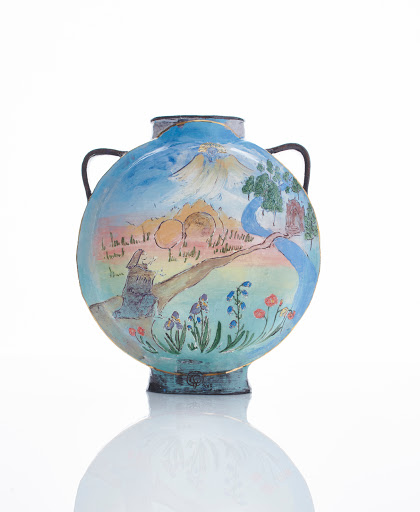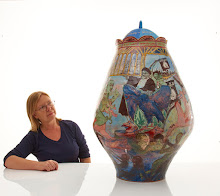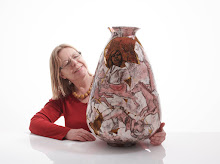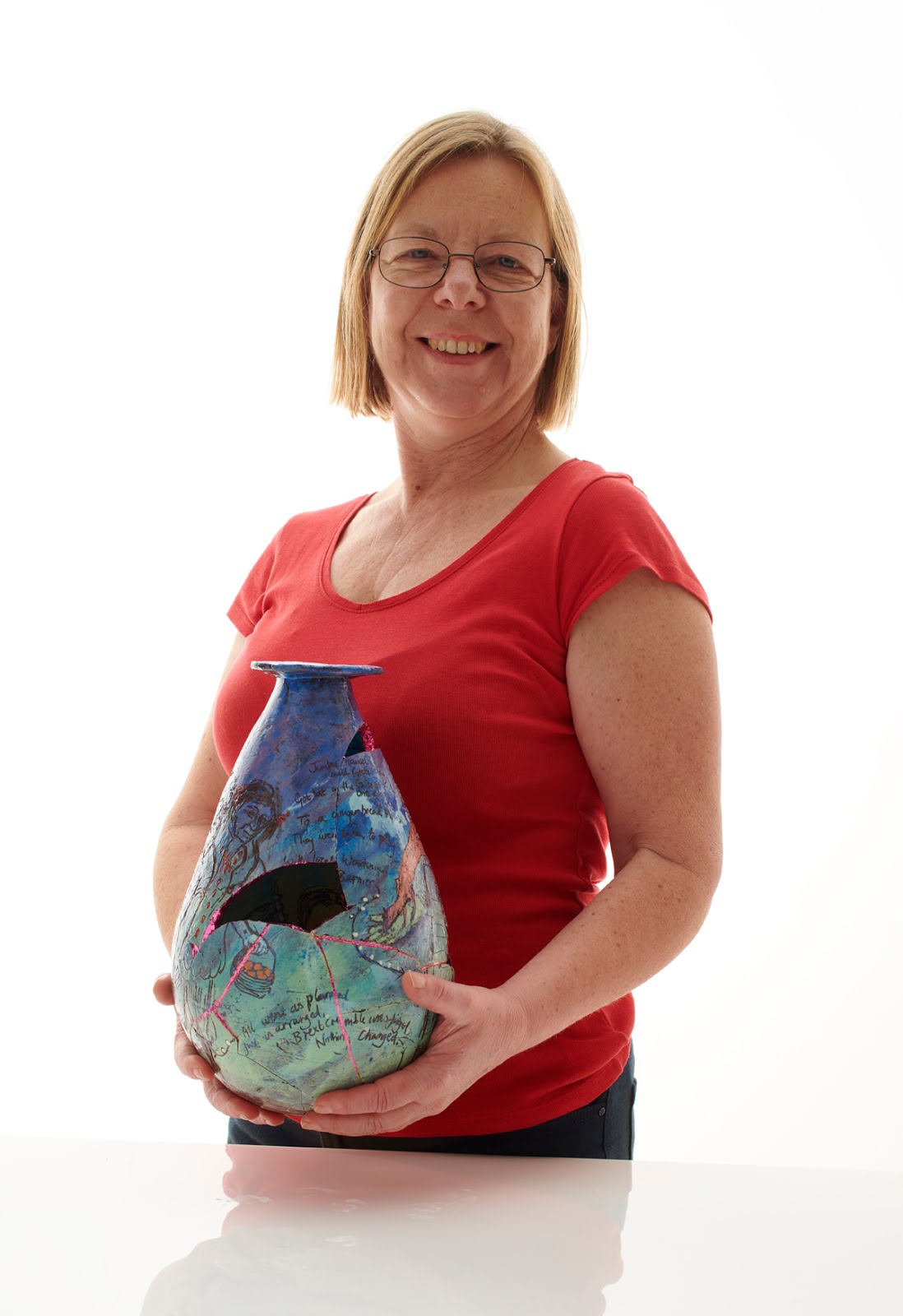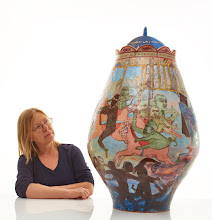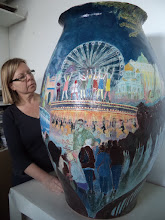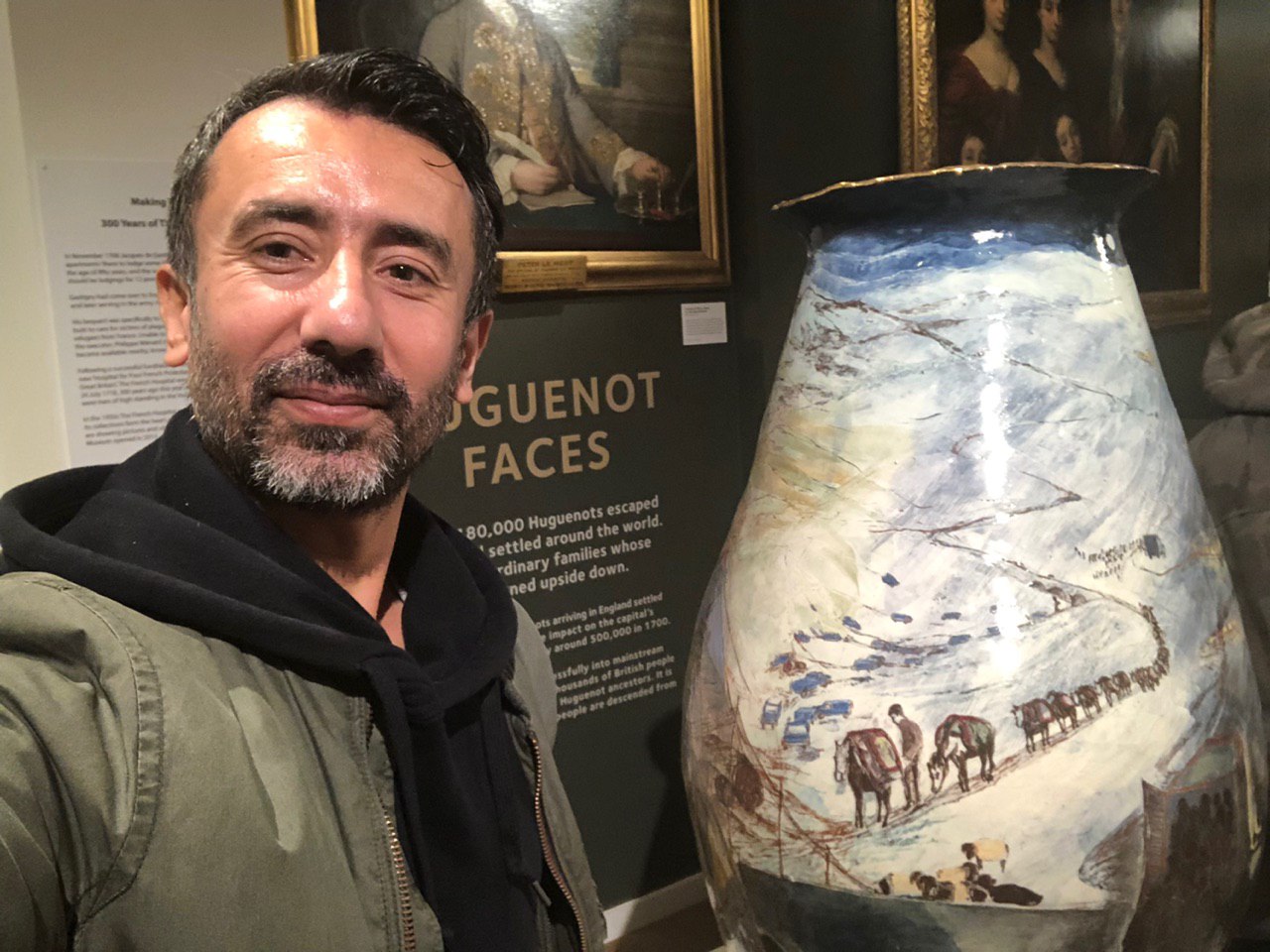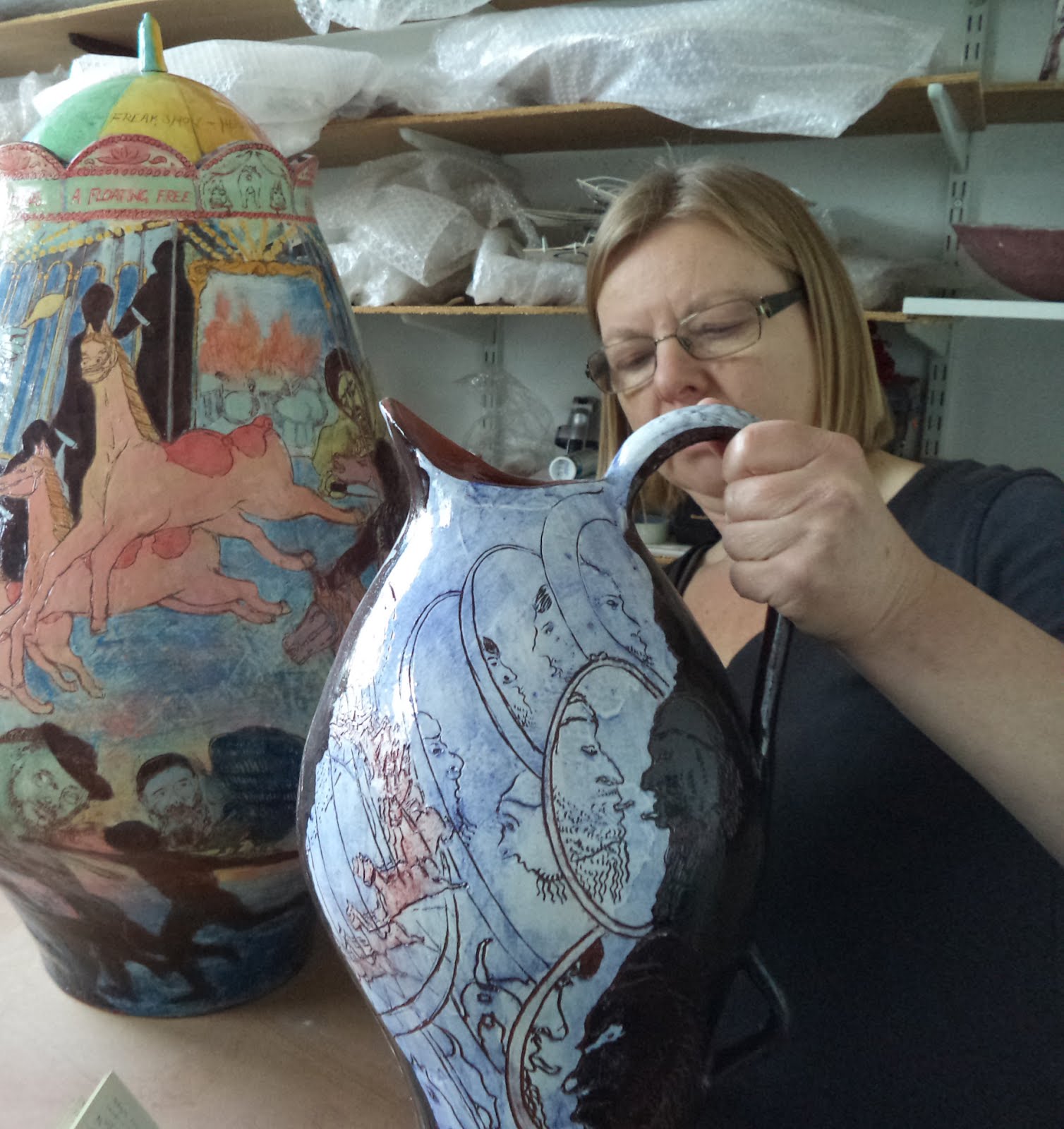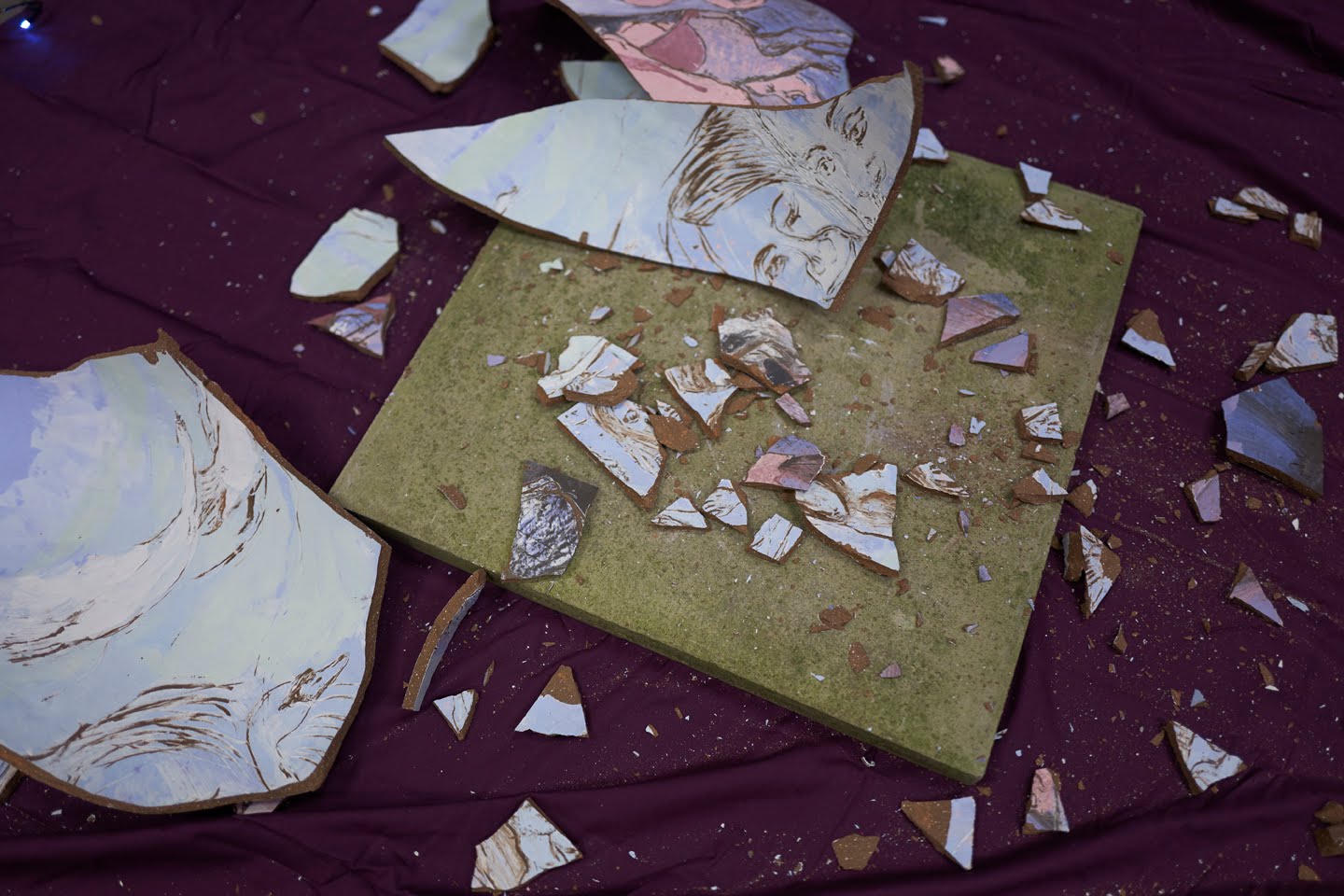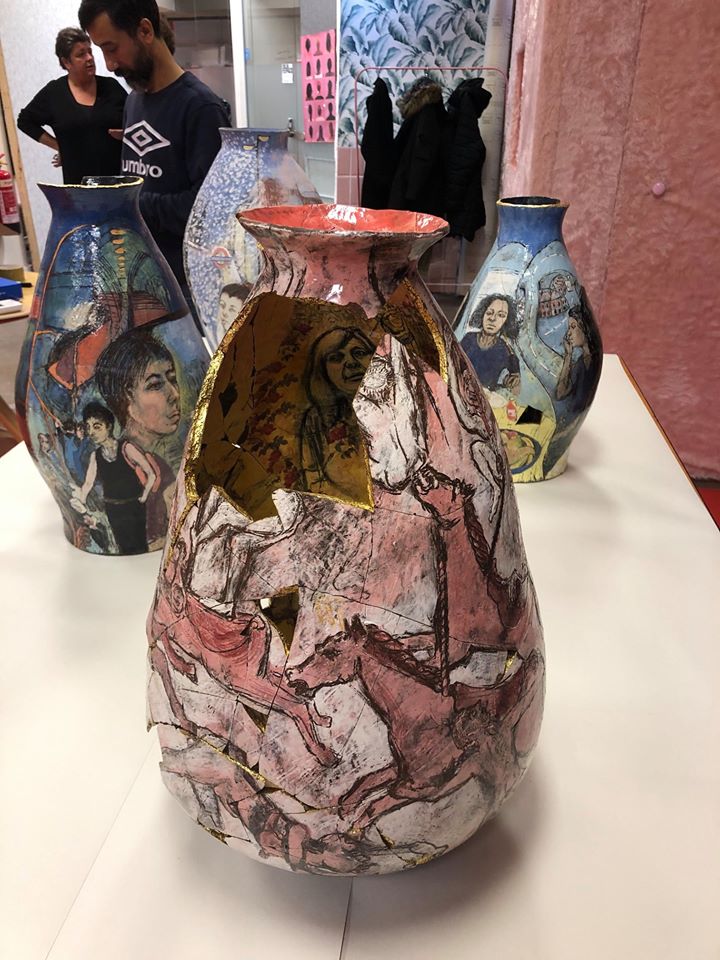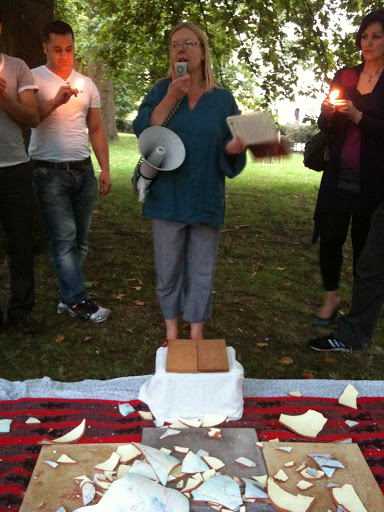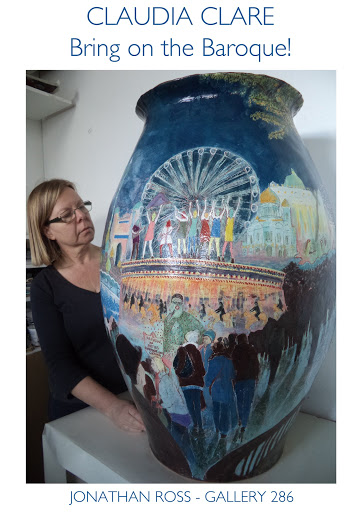The Workhouse, the Slum, the Slum Landlord and the Eternal Waiting-Room.
Some people are saying ‘the white working class’ has disappeared, some that class as a political issue has ‘got away,’ it has even been said that ‘we are all middle class now,’ but whichever way you look at it, you could hardly fail to notice that Britain is still infested with class structures of numerous sorts which blight lives and stifle minds.
For a while I thought we were just reinventing class; that we’d put the fences up in different places. Now I suspect we may be reintroducing some much older structures.The next six posts were written as one over the last few days and divided up to make it a bit more blog-friendly.
Sunday 23 March 2008
The Loathsome Peasant
My first candidate for reintroduction is the character of ‘The Loathsome Peasant.’ I noticed the return of this character, dragged back from the mid Eighteenth Century, when I lived in Yorkshire, in a village impoverished almost beyond retrieve. Surrounding this character was a motley crowd of influential others. Step forward: The Countryside Alliance, The (pro) Hunting Lobby, The (anti) Hunting Lobby, The Old Aristocracy, or what remains of them, and The New Aristocracy (‘media types,’ newspaper owners, their editors, some of their journalists, and most of the BBC).
‘The Loathsome Peasant,’ as constructed by the NAs, in particular, and their various stooges, is working class, or possibly lower middle class, lives in the country and isn’t very cultured. They might also live in a small town. They’re always racist, even if they’re black, which of course they never are because only white people live in the country. They’re probably not that well educated because the schools aren’t much good. The area is poor and these areas are concentrated in – well everywhere that isn’t a large thriving metropolitan centre and isn’t London or The South, or rather the ‘Home Counties’ with some other bits added on. In other words this character is probably the very same white working class who’s ‘disappeared.’ While the NAs would cheerfully execute the lot of them, which could be why they’ve disappeared, what really confuses the issue is that all those influential others, above named, also despise them. You see, they’re not Proper Peasants. They’re just a bit common.
‘The Loathsome Peasant,’ as constructed by the NAs, in particular, and their various stooges, is working class, or possibly lower middle class, lives in the country and isn’t very cultured. They might also live in a small town. They’re always racist, even if they’re black, which of course they never are because only white people live in the country. They’re probably not that well educated because the schools aren’t much good. The area is poor and these areas are concentrated in – well everywhere that isn’t a large thriving metropolitan centre and isn’t London or The South, or rather the ‘Home Counties’ with some other bits added on. In other words this character is probably the very same white working class who’s ‘disappeared.’ While the NAs would cheerfully execute the lot of them, which could be why they’ve disappeared, what really confuses the issue is that all those influential others, above named, also despise them. You see, they’re not Proper Peasants. They’re just a bit common.
A Yorkshire Village and the Urban Peasant
That Yorkshire village I mentioned provides a fine example of what I’m talking about. I was organising a community project which involved repairing the railings of the local community centre. Ah ha, thought I, let’s get the ‘Young Offenders Team’ in to do it, local participation and involvement and all that. The YOT were in fact part of social services, not, as the name suggests, a team of obliging local hooligans. The point is that the YOT worked with YOs, and supervised them doing good works around the county, in particular good works of the sort that ‘made reparation’ for the bad deeds they’d done before. So, along they come with their very sweet supervisor from Halifax and set to with the railings. Good reports of the day’s activities proliferated. ‘It can’t have been that exciting, surely,’ I thought, suspicious. Further enquiries revealed that the YOs, had indeed been having a whale of time: while they’d been working at the front of the community centre, the centre ‘workers’ had been cheerfully selling class A drugs out the back. It was only a matter of time before the too sweet supervisor had her back turned and a nice little circuit was set up.
This was how most people in the village were making their daily bread. They’d long given up on jobs. It’s not just that there weren’t any, there were never going to be any. Thus I decided to return to London to seek my fortune. Much as I loved that place, it really didn’t have a future. To my surprise, I found that the ‘Loathsome Peasant’ also lived in London. It took me a while to recognise him/her at first, because everyone, even the poor people, looked fantastically rich by comparison to the village. What I hadn’t grasped was that the rich-looking poor people were in fact just living on the never-never. The NAs despise the Urban Peasants in slightly different ways. Sometimes they use ‘social exclusion’ language, sometimes it’s about ‘under achievement,’ and much of the time its about ‘culture,’ which is the acceptable face of class, but contempt is contempt, whichever way you wrap it up.
This was how most people in the village were making their daily bread. They’d long given up on jobs. It’s not just that there weren’t any, there were never going to be any. Thus I decided to return to London to seek my fortune. Much as I loved that place, it really didn’t have a future. To my surprise, I found that the ‘Loathsome Peasant’ also lived in London. It took me a while to recognise him/her at first, because everyone, even the poor people, looked fantastically rich by comparison to the village. What I hadn’t grasped was that the rich-looking poor people were in fact just living on the never-never. The NAs despise the Urban Peasants in slightly different ways. Sometimes they use ‘social exclusion’ language, sometimes it’s about ‘under achievement,’ and much of the time its about ‘culture,’ which is the acceptable face of class, but contempt is contempt, whichever way you wrap it up.
The Workhouse
Next in line for reintroduction, also with a nice flavour of the mid Eighteenth Century is the Workhouse.
I live in Tottenham, an unlovely part of the North London Borough of Haringey. I love it, because I like my neighbours. But it is bleak. It has no centre and little soul and fairly bristles with workhouses. People migrate here from numerous different countries, but in the lattice of streets where I live, the population is mainly Kurdish, from Central Turkey. They are not PKK and need asylum as much to escape unwelcome and violent attention from that organisation as from the equally violent and unwelcome interference from the Turkish Gendarma, the military police. A mixture of studied ignorance and institutional brutality from the Home Office has resulted in large numbers of what can only be called Ignored Asylum Seekers. These are the ones who cannot be deported because their case for asylum is too good. So the HO has instead adopted a policy of first ignoring them and then criminalising them by refusing to allow them either to work or to claim benefit. They have to survive, so they work illegally and are exploited to the limits of their endurance.
So we have in Tottenham a critical mass of criminalised workers, who, as my friend Jamal did, work standing up for at least 14 hours a day with no break, (stop and think about that for a second), no day off and no holiday. He worked like this, without a single day off, for six years, rarely seeing the light of day, because mostly he worked nights. He is one of hundreds, possibly thousands. Jamal worked at the front of the shop, he met the customers; we all knew him. Most of the women, however, especially in the kebab and pizza shops, are at the back, in the kitchens. You wont see them. Our local economy is more or less dependent on these people. Remove them and we lose our entire local community. Welcome to Britain’s workhouses.
I live in Tottenham, an unlovely part of the North London Borough of Haringey. I love it, because I like my neighbours. But it is bleak. It has no centre and little soul and fairly bristles with workhouses. People migrate here from numerous different countries, but in the lattice of streets where I live, the population is mainly Kurdish, from Central Turkey. They are not PKK and need asylum as much to escape unwelcome and violent attention from that organisation as from the equally violent and unwelcome interference from the Turkish Gendarma, the military police. A mixture of studied ignorance and institutional brutality from the Home Office has resulted in large numbers of what can only be called Ignored Asylum Seekers. These are the ones who cannot be deported because their case for asylum is too good. So the HO has instead adopted a policy of first ignoring them and then criminalising them by refusing to allow them either to work or to claim benefit. They have to survive, so they work illegally and are exploited to the limits of their endurance.
So we have in Tottenham a critical mass of criminalised workers, who, as my friend Jamal did, work standing up for at least 14 hours a day with no break, (stop and think about that for a second), no day off and no holiday. He worked like this, without a single day off, for six years, rarely seeing the light of day, because mostly he worked nights. He is one of hundreds, possibly thousands. Jamal worked at the front of the shop, he met the customers; we all knew him. Most of the women, however, especially in the kebab and pizza shops, are at the back, in the kitchens. You wont see them. Our local economy is more or less dependent on these people. Remove them and we lose our entire local community. Welcome to Britain’s workhouses.
The Slum Landlord
Hogarth would be proud of our next candidate: The Slum and its cohort, The Slum Landlord. This comes complete with Gin Lane, or, more accurately, Cider Close.
Our local newspaper, ‘The Haringey Independent,’ excelled itself on Friday march 7th, ‘Migrant workers’ slum cleared out,’ it howled. Turned out a bunch of Polish men had set up camp under the arches next to the car park near Seven Sisters Tube station. The paper said about thirty people had been there for four weeks, but a small number have been there for some months, certainly since last summer. Directly related to this is the reintroduction of Lord Land-Scumbag, or The Slum Landlord. These are the buy-to-let vermin who bought up properties on the cheap, and let them to ‘asylums’ and migrant workers at extortionate prices. In order to pay the COLLOSSAL rent, a two bedroom flat, such as the one next door to me, will house anything up to twelve people. Two in each room including the living room, sleeping the day shift, and another two in each for the night shift. The charmless Goksun Guest House on the corner of my street also does this. After he’d finished his shift at the shop opposite, Jamal went to his bed which had just been vacated by Mehmet, only minutes before. Mehmet would then come downstairs to do the day shift.
Our local newspaper, ‘The Haringey Independent,’ excelled itself on Friday march 7th, ‘Migrant workers’ slum cleared out,’ it howled. Turned out a bunch of Polish men had set up camp under the arches next to the car park near Seven Sisters Tube station. The paper said about thirty people had been there for four weeks, but a small number have been there for some months, certainly since last summer. Directly related to this is the reintroduction of Lord Land-Scumbag, or The Slum Landlord. These are the buy-to-let vermin who bought up properties on the cheap, and let them to ‘asylums’ and migrant workers at extortionate prices. In order to pay the COLLOSSAL rent, a two bedroom flat, such as the one next door to me, will house anything up to twelve people. Two in each room including the living room, sleeping the day shift, and another two in each for the night shift. The charmless Goksun Guest House on the corner of my street also does this. After he’d finished his shift at the shop opposite, Jamal went to his bed which had just been vacated by Mehmet, only minutes before. Mehmet would then come downstairs to do the day shift.
The Servant Class and The Criminal Class
So we have the peasant, the slum dweller, the pitiful immigrant and the pitiless landlord. We are carefully reconstructing a labouring class from the people who have migrated here from the EU, and who work under restrictions. Romanians and Bulgarians can do only labouring work, no matter what their qualifications. ‘You keep the good jobs for the people from the rich countries,’ scowls Tavi, ‘You want people from the poor countries to do your shit work for you.’ We seem to have created a whole new ‘servant class’ from the Eastern European countries. These are the ‘respectable working class’ now. Those from outside the EU, with slightly darker skins and dodgy religious practices, like Jamal and Mehmet are the criminal classes. They’re the lucky ones though, relatively speaking. They have family here, and can avoid the worst excesses of Home Office Enforcement.
Consider Hasan, 20 years old, from Uzbekistan, here on his own, and without proper legal representation. Now electronically tagged, (a form of post modern leg-iron), he and his housemates are subject to relentless ‘visits’ from the Home Office at strange times of the night. Yet they wont deport him, or Samira, from Iran, who has so far managed to avoid the tagging, but only because she does have a good lawyer and a very politically aware brother to defend her. They both work the endless hours, and they’re both stuck forever in the Eternal Waiting Room while the HO also waits- to see who’ll blink first. Utterly guileless, Jamal is mystified by the refusal of his asylum claim: ‘I think the Home Office just don’t understand,’ he puzzles, trying to defend this institution of the democracy he loves. They understand alright, that’s why they make no active attempt to detain or deport him. They’re just trying to starve him out along with the others. I do sometimes wonder if ‘the workhouse’ is really the right word for this, in bleaker moments it seems more like a ghastly parody of the Gulag.
Consider Hasan, 20 years old, from Uzbekistan, here on his own, and without proper legal representation. Now electronically tagged, (a form of post modern leg-iron), he and his housemates are subject to relentless ‘visits’ from the Home Office at strange times of the night. Yet they wont deport him, or Samira, from Iran, who has so far managed to avoid the tagging, but only because she does have a good lawyer and a very politically aware brother to defend her. They both work the endless hours, and they’re both stuck forever in the Eternal Waiting Room while the HO also waits- to see who’ll blink first. Utterly guileless, Jamal is mystified by the refusal of his asylum claim: ‘I think the Home Office just don’t understand,’ he puzzles, trying to defend this institution of the democracy he loves. They understand alright, that’s why they make no active attempt to detain or deport him. They’re just trying to starve him out along with the others. I do sometimes wonder if ‘the workhouse’ is really the right word for this, in bleaker moments it seems more like a ghastly parody of the Gulag.
Strangers in Citizens
The obscene spectacle of a LABOUR GOVERNMENT adopting a policy of restricting some workers, criminalising others, recreating a ‘servant class’ and a ‘criminal class,’all to stop those frightful foreigners from coming to England to do the jobs no one else wants to do, was adopted to please the editor of the Daily Mail, who apparently, oh, you’re going to love this, REPRESENTS THE REST OF US AND OUR INTERESTS. Do you feel represented? Thought not. Taking action starts
Here. Strangers into Citizens has a pathway to citizenship proposal which would enable the Ignored Asylum Seekers to work legally and pay taxes and eventually to apply for citizenship given good references and so forth. S to C are working on a shoe string at the moment, and need help with their website among other things... if anyone has a few hours to spare....in the summer perhaps, that would be the business and The C Word will love you forever.
Here. Strangers into Citizens has a pathway to citizenship proposal which would enable the Ignored Asylum Seekers to work legally and pay taxes and eventually to apply for citizenship given good references and so forth. S to C are working on a shoe string at the moment, and need help with their website among other things... if anyone has a few hours to spare....in the summer perhaps, that would be the business and The C Word will love you forever.
Tuesday 18 March 2008
post from Linda Bloomfield re CLF

Introducing an intriguing post from Linda Bloomfield about the CLF. I know this sounds like the militant wing of Ceramic Review, but it's actually the Country Living Fair. Here's what she confides:
I have just returned from exhibiting at the Country Living Fair in Islington, which is for ladies from the country to come and do a day's shopping. The good thing about it is that you get huge numbers of customers who wouldn't go to the usual ceramics and craft fairs. They buy my pink cake stands, jugs and bowls and some come back every time to add to their collections. They come from as far away as Yorkshire and the Scilly Isles. There is not much competition from other potters, apart from the likes of Emma Bridgewater or similar. Makers there included Jane Cox, Anna Perring of Luna Lighting, Lucy Dunce, who makes beautifully decorated earthenware dishes, and Gemma Wightman. I also saw a few of Katrin Moye's luscious fat jugs on Margo Selby's (woven textiles) stand. If you make things which appeal to women from the town and country, then you can sell a large amount at this show.
Linda's website here.
Monday 17 March 2008
Glasgow School of Art: Save Our Ceramics Department
Monday 24th March 2008
The following is a statement from ceramics students as Glasgow School of Art:
New undergraduates will not now be accepted either for the full-time Ceramic degree course or for the part time course at the Glasgow School of Art. This is the end of undergraduate ceramic education in Scotland.
Following a recommendation by the Head of the School of Design, this decision, taken in haste without any staff or student consultation will have major implications for Scottish design, culture and tourism.
As ceramic students of GSA, we feel passionately that there is a promising future for ceramics in Scotland and are disappointed that GSA lacks the vision and courage to support a profitable and innovative element of the design school.
Their campaign networking group is on facebook
here
Links to petitions here and
here.
Its all very simple and quick and its a brilliant campaign so please suppport them!
And for any of you who have resisted the charms of facebook, this is your chance to breach its hallowed boundaries and you will find that its full of top flight ceramics gubbins.
The following is a statement from ceramics students as Glasgow School of Art:
New undergraduates will not now be accepted either for the full-time Ceramic degree course or for the part time course at the Glasgow School of Art. This is the end of undergraduate ceramic education in Scotland.
Following a recommendation by the Head of the School of Design, this decision, taken in haste without any staff or student consultation will have major implications for Scottish design, culture and tourism.
As ceramic students of GSA, we feel passionately that there is a promising future for ceramics in Scotland and are disappointed that GSA lacks the vision and courage to support a profitable and innovative element of the design school.
Their campaign networking group is on facebook
here
Links to petitions here and
here.
Its all very simple and quick and its a brilliant campaign so please suppport them!
And for any of you who have resisted the charms of facebook, this is your chance to breach its hallowed boundaries and you will find that its full of top flight ceramics gubbins.
Sunday 16 March 2008
‘Scared of being branded a “feminist”’
Friday March14th 2008
Branded? Can we just run that one past again? Branded? Who exactly is being branded here? Owch!
What is so frightening, so scorchingly terrifying, about someone thinking or saying you’re a feminist, that it counts as ‘branding’? It isn’t just a ‘figure of speech,’ it’s a profoundly emotive word. How could being considered a feminist possibly feel that bad? That frightening?
Why are artists, of almost any sort, so afraid of what this word means?
Ok, let’s try this out.
Let’s consider what really is frightening:
Being beaten half to death by your husband/ boyfriend/ ex-boyfriend/ father/ brother/ pimp/ dealer/ landlord/ mother’s husband/ boyfriend/ pimp/ dealer etc./ Yes. All of those, they’re all terrifying, and so is the threat of any one of them.
Being raped. Be it by ‘friend’/ boyfriend/ husband/ employer/ stranger/ all the rest etc. Yes. Unquestionably.
Attempting to report any of the above to the police, dealing with the Criminal Justice System and with predatory journalists. Yes.
Being scared of an impending home office visit, of the bang on the door at 5.00 am and finding the immigration police. Yes. Of deportation. Yes, be absolutely terrified.
Of Mahmood Ahmedinejad, the Guardian Council and the religious police. Yes. Of solitary confinement, interrogation and torture. Yes.
Approaching the check-point of the occupying army. Yes. Of landmines, of “precision” bombing, of ‘collateral damage,’ of snipers, of artillery fire from the surrounding hills, of car bombs, suicide bombers, death squads, partisan militias. In short of all forms of male violence, and in particular the organised, militarised sort. Yes. BE VERY VERY SCARED INDEED.
Of the aids test coming out positive. Yes. It is frightening. Of Alzheimer’s, of your sight or hearing or movement becoming impaired, changing, going. All dealable with to be sure, but all scary, especially at first and if it’s wholly unexpected.
Of being stuck up a big mountain on your own, at night. Of being in a desert without water. Of walking barefoot down a dry riverbed in Australia. JUST DON’T DO IT.
There are a thousand things to be scared of. Some truly terrifying. Some beyond the scope of what we can reasonably deal with. Others, scary at first, then become part of being normal.
But the lady at the laundrette thinking you might be a feminist? The shopkeeper thinking the same? Your daughters maths teacher suspecting a hint of radicalism perhaps? Someone asking if your work’s feminist? Or saying it is. Or writing it?
I’M SORRY. NO. If just doesn’t figure.
What kind of state of mass psychosis have we arrived in if we really are more scared of the woman who shouts about being raped, than we are of the suited gentleman (or the hooded gang) who raped her?
There will now a follow a couple of minute’s silence while we contemplate this state of intergalactic derangement.
Branded? Can we just run that one past again? Branded? Who exactly is being branded here? Owch!
What is so frightening, so scorchingly terrifying, about someone thinking or saying you’re a feminist, that it counts as ‘branding’? It isn’t just a ‘figure of speech,’ it’s a profoundly emotive word. How could being considered a feminist possibly feel that bad? That frightening?
Why are artists, of almost any sort, so afraid of what this word means?
Ok, let’s try this out.
Let’s consider what really is frightening:
Being beaten half to death by your husband/ boyfriend/ ex-boyfriend/ father/ brother/ pimp/ dealer/ landlord/ mother’s husband/ boyfriend/ pimp/ dealer etc./ Yes. All of those, they’re all terrifying, and so is the threat of any one of them.
Being raped. Be it by ‘friend’/ boyfriend/ husband/ employer/ stranger/ all the rest etc. Yes. Unquestionably.
Attempting to report any of the above to the police, dealing with the Criminal Justice System and with predatory journalists. Yes.
Being scared of an impending home office visit, of the bang on the door at 5.00 am and finding the immigration police. Yes. Of deportation. Yes, be absolutely terrified.
Of Mahmood Ahmedinejad, the Guardian Council and the religious police. Yes. Of solitary confinement, interrogation and torture. Yes.
Approaching the check-point of the occupying army. Yes. Of landmines, of “precision” bombing, of ‘collateral damage,’ of snipers, of artillery fire from the surrounding hills, of car bombs, suicide bombers, death squads, partisan militias. In short of all forms of male violence, and in particular the organised, militarised sort. Yes. BE VERY VERY SCARED INDEED.
Of the aids test coming out positive. Yes. It is frightening. Of Alzheimer’s, of your sight or hearing or movement becoming impaired, changing, going. All dealable with to be sure, but all scary, especially at first and if it’s wholly unexpected.
Of being stuck up a big mountain on your own, at night. Of being in a desert without water. Of walking barefoot down a dry riverbed in Australia. JUST DON’T DO IT.
There are a thousand things to be scared of. Some truly terrifying. Some beyond the scope of what we can reasonably deal with. Others, scary at first, then become part of being normal.
But the lady at the laundrette thinking you might be a feminist? The shopkeeper thinking the same? Your daughters maths teacher suspecting a hint of radicalism perhaps? Someone asking if your work’s feminist? Or saying it is. Or writing it?
I’M SORRY. NO. If just doesn’t figure.
What kind of state of mass psychosis have we arrived in if we really are more scared of the woman who shouts about being raped, than we are of the suited gentleman (or the hooded gang) who raped her?
There will now a follow a couple of minute’s silence while we contemplate this state of intergalactic derangement.
Investigating ‘The Feminine.’
Saturday March 15th 2008.
‘The feminine’ has been lurking in the long grass of the artist statement for some years now. I happened upon it again on Thursday night, at the opening night of 'Myths and Legends' at Contemporary Applied Bonnets and Silk Scarves in Percy St, London. (Oh yes. I get around.)
Clustered together there, like so many little Easter bunnies, was a cell of 'the Feminine.' I decided to chase them out and see what could be made of them.
I’ve used this expression, and I’ve found it used a few times by makers talking about their work, but what do we mean by it?
I use a very simple definition which is ‘characteristic of woman.’ This means pretty much anything from blistering fury or ‘well ‘ard,’ to any of those gentle nurturing characteristics which are supposed to be found in abundance among females. Thing is, you can’t nurture without getting into a state of blistering rage or being well ‘ard as well. They’re part of each other’s territory.
‘Feminine’ can also mean that peculiarly sanitised, diminished, bleached, washed out, enfeebled version of woman – the sort that never gets angry, doesn’t smell of anything except soap, doesn’t bleed, except her heart of course, and the reason you’ve never met her is because she doesn’t exist, and never has. She is, of course, just a construct. So we can discard her for now. Actually how about forever?
A third use of the word seems to be creeping slowly into accepted-use status. ‘Concerned with "the feminine"’ seems to be – SHUDDER- the acceptable face of feminism. Feminism was never meant to have an acceptable face. THAT’S THE WHOLE POINT. But it does appear to be used by women, mostly, whose work or activities are obviously influenced or in some way shaped by feminist thinking, but who for some inexplicable reason, don’t want to say so and instead opt for something which is, apparently, more acceptable. Nicer. Problem is, if you return to the simple linguistic definition, ‘characteristic of woman,’ it isn’t any ‘nicer,’ just womanly.
‘The feminine’ has been lurking in the long grass of the artist statement for some years now. I happened upon it again on Thursday night, at the opening night of 'Myths and Legends' at Contemporary Applied Bonnets and Silk Scarves in Percy St, London. (Oh yes. I get around.)
Clustered together there, like so many little Easter bunnies, was a cell of 'the Feminine.' I decided to chase them out and see what could be made of them.
I’ve used this expression, and I’ve found it used a few times by makers talking about their work, but what do we mean by it?
I use a very simple definition which is ‘characteristic of woman.’ This means pretty much anything from blistering fury or ‘well ‘ard,’ to any of those gentle nurturing characteristics which are supposed to be found in abundance among females. Thing is, you can’t nurture without getting into a state of blistering rage or being well ‘ard as well. They’re part of each other’s territory.
‘Feminine’ can also mean that peculiarly sanitised, diminished, bleached, washed out, enfeebled version of woman – the sort that never gets angry, doesn’t smell of anything except soap, doesn’t bleed, except her heart of course, and the reason you’ve never met her is because she doesn’t exist, and never has. She is, of course, just a construct. So we can discard her for now. Actually how about forever?
A third use of the word seems to be creeping slowly into accepted-use status. ‘Concerned with "the feminine"’ seems to be – SHUDDER- the acceptable face of feminism. Feminism was never meant to have an acceptable face. THAT’S THE WHOLE POINT. But it does appear to be used by women, mostly, whose work or activities are obviously influenced or in some way shaped by feminist thinking, but who for some inexplicable reason, don’t want to say so and instead opt for something which is, apparently, more acceptable. Nicer. Problem is, if you return to the simple linguistic definition, ‘characteristic of woman,’ it isn’t any ‘nicer,’ just womanly.
'The Human Condition'
Since we’re now investigating the more squalid reaches of the above mentioned long grass, could we now discard this one too… forever? If anyone writes in muttering flakily about ‘the human condition,’ I SHALL enable the moderator. You have been warned. We shall have no more of this sort of nonsense, not on this blog anyway, because, it doesn’t mean anything. There is no ‘human condition.’ Our conditions are not universal. They never were. And I’m a fully paid up, hard-core, structuralist, which is how I know there are no universally shared human conditions. The impossibly complicated web of social and political structures, which enmesh our lives, forbids the existence of such a beast.
Sunday 9 March 2008
More on The C Word's purpose
Next posting, same day, more on The C Word’s purpose.
Interviews:
The Crafts Council – the ultimate C word – What is it good for? This, I hope, will be the first official in-depth C Word interview. I’ll keep you posted.
Next, I very much want all of you to write in and tell The C Word about your projects, shows, happenings, research. Yes, that’s ALL of you. Be you pit-firing in tipis, or hard-core theorising in isms, I want to know about ALL OF IT, especially students/learners, and above all, I want to hear from Feminists, pro-feminists and might-be-feminists and what you’re working on. Just one request – keep it short, say 2-300 words in the first instance. If some really chewy stuff comes back I might start another sister blog, or I’ll find a way of re-routing the weightier stuff, so it’s got its own grazing area. We’ll see.
Ah yes, The C Word does lean towards ceramics, in fact it’s pretty much exclusively about ceramics so far, and yes that is one its primary purposes. This is the bit I want to kick off first. The rest will come, and if it doesn’t, then that is because matters ceramicy are absorbing all my energy for now. As above: we’ll see.
Finally, I plan to continue reviewing events, and new writing on ceramics and anything else that looks interesting.
Links now live, and some more to be tracked down. will eventually upload some pictures on to the site to pretty it up a bit.
Interviews:
The Crafts Council – the ultimate C word – What is it good for? This, I hope, will be the first official in-depth C Word interview. I’ll keep you posted.
Next, I very much want all of you to write in and tell The C Word about your projects, shows, happenings, research. Yes, that’s ALL of you. Be you pit-firing in tipis, or hard-core theorising in isms, I want to know about ALL OF IT, especially students/learners, and above all, I want to hear from Feminists, pro-feminists and might-be-feminists and what you’re working on. Just one request – keep it short, say 2-300 words in the first instance. If some really chewy stuff comes back I might start another sister blog, or I’ll find a way of re-routing the weightier stuff, so it’s got its own grazing area. We’ll see.
Ah yes, The C Word does lean towards ceramics, in fact it’s pretty much exclusively about ceramics so far, and yes that is one its primary purposes. This is the bit I want to kick off first. The rest will come, and if it doesn’t, then that is because matters ceramicy are absorbing all my energy for now. As above: we’ll see.
Finally, I plan to continue reviewing events, and new writing on ceramics and anything else that looks interesting.
Links now live, and some more to be tracked down. will eventually upload some pictures on to the site to pretty it up a bit.
Ceramic Art London, Feb 29 - March 2nd 2008

Ceramic Art London, website here is a big posh pottery fair that takes place in the Dinosaur Paddock at the back of the Natural History Museum, in what was once another of the C word’s temples: the Royal Palace of Applied Yawns. It’s an iffy looking 70s building between Kensington Bore and the Consorting Princes, nuzzling up to Prince Albert and the Royal Organ. You can look at the A-Z and see for yourself. Well, imagine my surprise, to find, once again, the White Rabbit lurking in the undergrowth, looking much more sprightly this time though and no sooner had I spotted him, than I heard the Giant Dormouse was shortly, ok tally, to be expected - you know a girl can start to feel stuck in an action replay glitch at these events after a while.
Back at the fair however, the worker bees were at their many splendoured stalls. CAL is pretty much either domestic scale pots, or domestic scale figures. There are a couple of exceptions, - I’m coming to them, - but in the main it’s pots and figures. There is something weirdly interesting about ceramic figures, as long as they’re not trying to be – well – arty. It’s the unapologetically ceramicy ones that seem to work. I mean like china figurines, a bit camp. I’m thinking of Craig Mitchell’s shiney shiney pottery characters, website here and Carole Windham’s trophy-like ‘ornaments’, website here both of which are satires, I suppose, and self consciously refer to mantelpiece figures. I certainly prefer them to the earnest ‘truth to materials’ brigade – ‘female’ figures with no bosoms – I’m sorry I just can’t be doing with that sort of thing. Happily, neither could the selectors at CAL, it seems, at any rate they weren’t there – hooray! Or maybe they’ve just gone out of fashion. Even bigger Hooray.
This posting is going to celebrate inconsistency, because the ‘earnest truth to materials’ pots were out in force and I loved them. Gareth Mason’s giant placenta and toothpaste blobs oozed – I think he’s finding his feminine self, or the pot’s feminine self, and Richard Phethean’s big earthenware gestural jugs - um – thrusted – yep, masculine, but in the most cheerful sort of way. (Pictures on CAL website, more links to be added.)
The post-modern strand was admirably represented by Philomena Pretsell – welcome back- whose stall sported a fine collection of her pastry-folded domestic table-ware/ display-ware with lots of gold and drawings on so you’re not in any doubt at all about its desire to decorate- with brass knobs on. It’s aggressively feminine – HOORAY x 100 – with anxious moments, sort of flickering. Quite menopausal really, which is probably why I liked it so much. It’s those purple patches that do it, and a fiercely counter-intuitive smudge on the rim of a yellow cup where she’s brushed something on that’s come out brownish, and you know it’s a really bad lipstick moment. LOVE IT. (Pictures on CAL website and above)
It’s difficult to avoid a beauty parade with this kind of gig, because in many ways that’s exactly what it is, Ceramics’s annual fashion show. It’s not representative, it doesn’t show installation or architectural work, or any of the mixed media or cross-disciplinary work, so it’s a glimpse of some of what goes on in contemporary ceramics, rather than a survey, but no worse for that. The CPA, - there goes another C word, this is the Craft Potters Association – awards a prize, which went to a very sleek selection by Carina Ciscato, so, not to be left out, The C Word will award some prizes too.
Drum Roll:
The winner of this year’s, inaugural, Golden Fanny plus rosette for Best in Show 2008 goes to Aneta Regel Deleu,
website here for her truly fabulous blistered, pitted, festering, glorious mint green, yellow and red confections, neither pot nor figure , which lied about the materials, and established a different set of truths. GORGEOUS.
Highly Commended Golden Fanny rosettes go to Gareth Mason and to Philomena Pretsell, who celebrated the feminine from opposite ends of the ceramic spectrum.
Now all I have to do is persuade the Temple of the Applied Arts – that’s the one NEXT to the Natural History Museum to host the award ceremony sometime. This ambition will have to wait though, because The C Word has other matters to attend to.
Friday 7 March 2008
Collect and other animals
So, finally some thoughts on the rank evil that is Collect.
website here
I admitted that I didn’t get there this year, and I’ve a feeling I didn’t last year, or if I did it was spectacularly unmemorable. The most memorable year for me was when I stumbled in on the coat tails of the White Rabbit, who kept pulling a gold watch out of his waistcoat pocket and muttering, ‘my ears and whiskers, so much FLIM FLAM,’ before scampering off into the undergrowth to edit his parish council pottery review. I clearly remember finding myself in a room full of weird shaped china, with a large table, in the middle of which was a miniature celadon tea pot, over which was slumped a giant sized dormouse, with whom, apparently, I was to have ‘supervision’. Since the dormouse continued his slumbers, oblivious to the world, I slipped past and into another vast strange room, in which I found ‘Ratty’, sitting in a big chair on a stage, and on either side of him – actually he’d had his gender reassigned and was now she – on either side of HER, were a Badger, called Julian, an extraordinarily cantankerous fellow in a velvet smoking jacket, and a Toad, called Grayson, in a ludicrous flounced frock with bells and ribbons. They were discussing death, coffins, and sarcophagi. The more cantankerous Badger got, the more Ratty tried to intervene, and the more Toad just said ‘toot toot’, greatly to the amusement of the audience; apparently he had a very fine collection of very fast flash motorbikes, and just wanted to show them off. Badger and Toad both made clay pots in their spare time it seemed. Ratty talked and wrote about them, the pots, not B and T. Eventually Toad flounced off, climbed into primrose yellow car and, with one last ‘Toot Toot’, sped away. Ratty scuttled off and investigated the rest of the Collect sewer, and Badger growled at everyone and brushed up his velvet jacket. I went to look for the dormouse and his ‘supervision’ again, but was told he’d retreated to his tank with a group of other rodents to do some thinking. Apparently he had to rethink the entire 20th Century. No wonder the poor chap was comatose. I gloomily wandered out into the February sunshine and found my sister on the Temple bank, who nudged me awake, gave me good strong cup of tea, and said ‘Well whatsortofmug goes to Collect anyway?’
for a different take on collecting, consumption, and how to drink a mug of tea click here
website here
I admitted that I didn’t get there this year, and I’ve a feeling I didn’t last year, or if I did it was spectacularly unmemorable. The most memorable year for me was when I stumbled in on the coat tails of the White Rabbit, who kept pulling a gold watch out of his waistcoat pocket and muttering, ‘my ears and whiskers, so much FLIM FLAM,’ before scampering off into the undergrowth to edit his parish council pottery review. I clearly remember finding myself in a room full of weird shaped china, with a large table, in the middle of which was a miniature celadon tea pot, over which was slumped a giant sized dormouse, with whom, apparently, I was to have ‘supervision’. Since the dormouse continued his slumbers, oblivious to the world, I slipped past and into another vast strange room, in which I found ‘Ratty’, sitting in a big chair on a stage, and on either side of him – actually he’d had his gender reassigned and was now she – on either side of HER, were a Badger, called Julian, an extraordinarily cantankerous fellow in a velvet smoking jacket, and a Toad, called Grayson, in a ludicrous flounced frock with bells and ribbons. They were discussing death, coffins, and sarcophagi. The more cantankerous Badger got, the more Ratty tried to intervene, and the more Toad just said ‘toot toot’, greatly to the amusement of the audience; apparently he had a very fine collection of very fast flash motorbikes, and just wanted to show them off. Badger and Toad both made clay pots in their spare time it seemed. Ratty talked and wrote about them, the pots, not B and T. Eventually Toad flounced off, climbed into primrose yellow car and, with one last ‘Toot Toot’, sped away. Ratty scuttled off and investigated the rest of the Collect sewer, and Badger growled at everyone and brushed up his velvet jacket. I went to look for the dormouse and his ‘supervision’ again, but was told he’d retreated to his tank with a group of other rodents to do some thinking. Apparently he had to rethink the entire 20th Century. No wonder the poor chap was comatose. I gloomily wandered out into the February sunshine and found my sister on the Temple bank, who nudged me awake, gave me good strong cup of tea, and said ‘Well whatsortofmug goes to Collect anyway?’
for a different take on collecting, consumption, and how to drink a mug of tea click here
Think Tank
Saturday, Januaray 27th, saw the Think Tank Party. Now I know that sounds like a contradiction in terms, but it was a party of sorts. Perhaps more plotting than partying, more networking than thinking, but hey, they tried. And I tried too.
This too was staged at a venerable institution of planet C, commonly known as Contemporary Applied Arts, or the CAA. It lurks on the north side of Oxford St. in central London, and sells things, most of the time. That, at least, is its purpose, and as far as I know, it acquits itself admirably, or is doing so now after a bad patch, by all accounts.
One day, I promise, The C Word will delve into the sordid underbelly of the Craft’s political/social (?) economy, and find who exactly does fund who and who knows who, taught who, is propped up by who, and how the whole ghastly closed-shop edifice is constructed and maintained, and how the hegemonic practices, of ceramics in particular, are hedged in, protected, regularly clipped, and by whom. But that could take a while, and is a digression from our current concerns with the TANK.
link to website here
Think Tank, for those not in the know, was dreamed up about four years ago, in a small Austrian town called Gmunden, by one Gabi Dewald, who invited ‘some of the most committed thinkers in the field of applied art from right across Europe’ to ‘lay a theoretical foundation for the concept of the applied art in Europe today.’ My guess is we’re now about half way through Think Tank’s natural life span. They’ve produced four publications, three of which have accompanied exhibitions, which themselves respond to a concept, which is discussed in the seminar papers published in the books. The first of the three exhibitions, and therefore the title of the collected, published papers, was called ‘Languages’; the second was ‘Place(s)’; the third, ‘Gift’. The first of the publications was called ‘The Foundation,’ in which the contributors discussed their reasons for participating in Think Tank and what they considered the purpose of the beast to be. So, Gift was the exhibition hosted at the CAA, whose papers are now published in the book of the same name. Ok so far?
Word on the craft corridor is that the Tank members each chose a piece of work they like, and want to talk about in terms of the proscribed concept, pop it in their handbags, bring it to the exhibition space and lob it on a plinth. I imagine the process isn’t quite as cavalier as this, this is simply what my, probably rather unreliable, source told me, but the point is that the shows are curated by the members (nine writers from eight countries) and assembled in situ. In other words the curatorial process is predicated on the concept, almost as though the concept, ‘gift’ in this case, does the curating, or at least has the casting vote. Make no mistake, this has produced some wonderful shows. That said, the last two, Gift and Place(s), has had a cobbled together look. The first time, it felt like a welcome break from the preciousness of craft curating. The second time, it’s starting to look like a bad habit.
One of the most important things about these shows is the writing, which also appears in the gallery space with each of the objects exhibited. These are the thoughts of the individual who chose that piece in response to the concept. Place(s) and Gift both were shown at the CAA, and in both shows, the objects were set out on big white plinths with typed statements next to them. As I said it looked clunky but home made and interesting the first time. Now I want to see the writing look like it really is part of the show. I want to see it curated. I love what Think Tank does and I don’t want it to be part of miserable little note left in a survey of craft centred art practices. So, I’m hoping for a LOT MORE punch in the next show. It still has the small-but-perfectly-formed-objects look to it, but that may just be what the Thinkers like. No disrespect intended to the makers here, the ‘look’ is what happens when you put them all together. I’d like to see all this seminar-ing and laying of theoretical foundations to have some real weight which is made visible, and indeed material, in the exhibitions themselves.
This too was staged at a venerable institution of planet C, commonly known as Contemporary Applied Arts, or the CAA. It lurks on the north side of Oxford St. in central London, and sells things, most of the time. That, at least, is its purpose, and as far as I know, it acquits itself admirably, or is doing so now after a bad patch, by all accounts.
One day, I promise, The C Word will delve into the sordid underbelly of the Craft’s political/social (?) economy, and find who exactly does fund who and who knows who, taught who, is propped up by who, and how the whole ghastly closed-shop edifice is constructed and maintained, and how the hegemonic practices, of ceramics in particular, are hedged in, protected, regularly clipped, and by whom. But that could take a while, and is a digression from our current concerns with the TANK.
link to website here
Think Tank, for those not in the know, was dreamed up about four years ago, in a small Austrian town called Gmunden, by one Gabi Dewald, who invited ‘some of the most committed thinkers in the field of applied art from right across Europe’ to ‘lay a theoretical foundation for the concept of the applied art in Europe today.’ My guess is we’re now about half way through Think Tank’s natural life span. They’ve produced four publications, three of which have accompanied exhibitions, which themselves respond to a concept, which is discussed in the seminar papers published in the books. The first of the three exhibitions, and therefore the title of the collected, published papers, was called ‘Languages’; the second was ‘Place(s)’; the third, ‘Gift’. The first of the publications was called ‘The Foundation,’ in which the contributors discussed their reasons for participating in Think Tank and what they considered the purpose of the beast to be. So, Gift was the exhibition hosted at the CAA, whose papers are now published in the book of the same name. Ok so far?
Word on the craft corridor is that the Tank members each chose a piece of work they like, and want to talk about in terms of the proscribed concept, pop it in their handbags, bring it to the exhibition space and lob it on a plinth. I imagine the process isn’t quite as cavalier as this, this is simply what my, probably rather unreliable, source told me, but the point is that the shows are curated by the members (nine writers from eight countries) and assembled in situ. In other words the curatorial process is predicated on the concept, almost as though the concept, ‘gift’ in this case, does the curating, or at least has the casting vote. Make no mistake, this has produced some wonderful shows. That said, the last two, Gift and Place(s), has had a cobbled together look. The first time, it felt like a welcome break from the preciousness of craft curating. The second time, it’s starting to look like a bad habit.
One of the most important things about these shows is the writing, which also appears in the gallery space with each of the objects exhibited. These are the thoughts of the individual who chose that piece in response to the concept. Place(s) and Gift both were shown at the CAA, and in both shows, the objects were set out on big white plinths with typed statements next to them. As I said it looked clunky but home made and interesting the first time. Now I want to see the writing look like it really is part of the show. I want to see it curated. I love what Think Tank does and I don’t want it to be part of miserable little note left in a survey of craft centred art practices. So, I’m hoping for a LOT MORE punch in the next show. It still has the small-but-perfectly-formed-objects look to it, but that may just be what the Thinkers like. No disrespect intended to the makers here, the ‘look’ is what happens when you put them all together. I’d like to see all this seminar-ing and laying of theoretical foundations to have some real weight which is made visible, and indeed material, in the exhibitions themselves.
Craft Rocks, Linda Florence, and Spectacular Craft
Friday Feb 8th 2008 continued:
The next Big Thing was Craft Rocks. One could be forgiven for thinking that the otherwise unpromising title must have a least a hint of irony, but as far as I could tell, none was present. That said, there was strong whiff of high camp drifting through the cast gallery. This turned out to be icing sugar, which had been lovingly set out in imitation of gracefully pattered floor tiles. This, the dance and icing sugar were the idea and work of Linda Florence. The stately rooms of the V&A were slowly being turned into a sugar dust-bowl as three pairs of magnificent ballroom dancers where waltzing, tangoing, and two-stepping this way and that across the ‘tiles’, creating voluminous clouds of sugar as they went. Mesmerising though it was, the audience got steadily sweeter and stickier and the sugar dust settled in our hair and eyebrows and in the fold of our clothing and rose in mighty billowing waves to settle on high balconies, paintings, statues, in distant curlicues and on the cheeks of cherubs. Wonderful stuff at best, but I’m still worried about the cleaning bill.
Craft was being splendidly rejuvenated in the Temple of the Applied Arts. ‘Out of the Ordinary,’ subtitled, ‘Spectacular Craft,’ also surpassed its excruciatingly clunky titles with an exhibition, ‘of eight contemporary artists who place craft at the heart of their practice.’
pictures here
What is truly astonishing about this is that it was a collaboration, in name at least, between The Temple and The Politburo (aka the Crafts Council). In reality it seems to have been the work of about 20 people as well as the eight artists, most of whom have little or no connection with the Politburo. The first thing to note was the absence of the loathsome plinth. Gone too the pious silence that clings like a virus to most displays of the ‘beautifully crafted’ item. Here was a screaming cascade of lacerated red paper, tumbling exuberantly, extravagantly from open books, whose cut pages generated the torrent. More viciously cut paper dolls filled box frames; the caught, caged versions of escaping paper, which filled a corner from ceiling to floor. There is so much more that could be said about this show, and perhaps someone else will write it, but I will just mention the exhibition design. The room was divided into sections using giant cast plaster blocks on which some exhibits were mounted, perfect for Susan Collis’s gold screws and brown diamond drawing pins, for example. What joy it was to see a show dedicated to craft practices, properly, thoughtfully exhibited. Curators, Take Note!!!
The next Big Thing was Craft Rocks. One could be forgiven for thinking that the otherwise unpromising title must have a least a hint of irony, but as far as I could tell, none was present. That said, there was strong whiff of high camp drifting through the cast gallery. This turned out to be icing sugar, which had been lovingly set out in imitation of gracefully pattered floor tiles. This, the dance and icing sugar were the idea and work of Linda Florence. The stately rooms of the V&A were slowly being turned into a sugar dust-bowl as three pairs of magnificent ballroom dancers where waltzing, tangoing, and two-stepping this way and that across the ‘tiles’, creating voluminous clouds of sugar as they went. Mesmerising though it was, the audience got steadily sweeter and stickier and the sugar dust settled in our hair and eyebrows and in the fold of our clothing and rose in mighty billowing waves to settle on high balconies, paintings, statues, in distant curlicues and on the cheeks of cherubs. Wonderful stuff at best, but I’m still worried about the cleaning bill.
Craft was being splendidly rejuvenated in the Temple of the Applied Arts. ‘Out of the Ordinary,’ subtitled, ‘Spectacular Craft,’ also surpassed its excruciatingly clunky titles with an exhibition, ‘of eight contemporary artists who place craft at the heart of their practice.’
pictures here
What is truly astonishing about this is that it was a collaboration, in name at least, between The Temple and The Politburo (aka the Crafts Council). In reality it seems to have been the work of about 20 people as well as the eight artists, most of whom have little or no connection with the Politburo. The first thing to note was the absence of the loathsome plinth. Gone too the pious silence that clings like a virus to most displays of the ‘beautifully crafted’ item. Here was a screaming cascade of lacerated red paper, tumbling exuberantly, extravagantly from open books, whose cut pages generated the torrent. More viciously cut paper dolls filled box frames; the caught, caged versions of escaping paper, which filled a corner from ceiling to floor. There is so much more that could be said about this show, and perhaps someone else will write it, but I will just mention the exhibition design. The room was divided into sections using giant cast plaster blocks on which some exhibits were mounted, perfect for Susan Collis’s gold screws and brown diamond drawing pins, for example. What joy it was to see a show dedicated to craft practices, properly, thoughtfully exhibited. Curators, Take Note!!!
Anders Ruhwald at 6pm studio
Friday 8th Feb. 2008 – Anders Ruhwald at 6pm studio
I woke up on Wednesday, and ‘Oh, bugger,’ I thought, ‘I’ve missed it again,’ I thought and again ‘Oh BUGGER,’ as I realised that this was the last 'Collect' at the V&A that had drifted slowly past me. Oh well it was a busy week for the Craft Circuit, and how often can one say that?
I did get to 'Collect' once, twice in fact, but I’ll come back to that.
Right now, it’s time for a bit of hard-core craft analysis/gossip.
First we’ll take a trip to South London, to Tulse Hill in fact, to the throbbing heart of happening ceramics, the studio of Edmund de Waal, where the first outing, (23rd -27th Jan. 2008), of the 6pm workspace was strutting its stuff with giant worm-like creatures propped up on sticks like some appalling genetically modified allotment nightmare.
pictures here and here
The vile progeny were not only vast, for worms, but toxic colours, mauve, yellow and orange. Exactly the sort of thing you really don’t want either on your allotment, or in your studio. They looked like they were made of fibre-glass, but apparently they were earthenware. I kept having all the wrong thoughts, like, ‘I wonder how much they weigh.’
It’s a strange thing, You have to be very deeply dug into ceramics really to get any kind of conversation going with these works. ‘Form and Function’ it bravely asserted. This was the title. To ‘get’ it you have to know Mr. Leach. Well to ‘get’ that side of it at least. Otherwise you can just get into their creepiness, which is largely about identifying with the other sort of Leech.
Ok, so let’s be perverse, and pretend for a moment that they are made of fibre glass, or some kind of plastic. They have a sort of upside down IKEA look to them. They’re made by one Anders Ruhwald. Danish chap. I like them better now they’re made of fibre glass, because I can move them around my loft apartment. They somehow seem more alive. They’re just a bit too turdy as clay. No two ways about it, I’m more charmed by the Leech discourse than I am by the Leach discourse, or the anti-Leach discourse as this would presumably be. Looking on the bright side however, we are, presumably, seeing the first stirrings of the Ceramics Establishment, lumbering slowly away from its relentless preoccupation with solid, stupefyingly dull, modernism. We’re on un-truth to materials now apparently. Halleluja. But dear god, please let those leeches be speedy movers. What bliss it would be to leave all that stuff behind and glide gracefully into a Ceramics Spring. Is this really so much to ask for? But then what would the establishment do?
I guess I should be optimistic; these worms are trying that long-preserved ceramic virtue. I wish they’d get a move on though, so the rest of us can get out of the mausoleum and embrace in the sun.
I woke up on Wednesday, and ‘Oh, bugger,’ I thought, ‘I’ve missed it again,’ I thought and again ‘Oh BUGGER,’ as I realised that this was the last 'Collect' at the V&A that had drifted slowly past me. Oh well it was a busy week for the Craft Circuit, and how often can one say that?
I did get to 'Collect' once, twice in fact, but I’ll come back to that.
Right now, it’s time for a bit of hard-core craft analysis/gossip.
First we’ll take a trip to South London, to Tulse Hill in fact, to the throbbing heart of happening ceramics, the studio of Edmund de Waal, where the first outing, (23rd -27th Jan. 2008), of the 6pm workspace was strutting its stuff with giant worm-like creatures propped up on sticks like some appalling genetically modified allotment nightmare.
pictures here and here
The vile progeny were not only vast, for worms, but toxic colours, mauve, yellow and orange. Exactly the sort of thing you really don’t want either on your allotment, or in your studio. They looked like they were made of fibre-glass, but apparently they were earthenware. I kept having all the wrong thoughts, like, ‘I wonder how much they weigh.’
It’s a strange thing, You have to be very deeply dug into ceramics really to get any kind of conversation going with these works. ‘Form and Function’ it bravely asserted. This was the title. To ‘get’ it you have to know Mr. Leach. Well to ‘get’ that side of it at least. Otherwise you can just get into their creepiness, which is largely about identifying with the other sort of Leech.
Ok, so let’s be perverse, and pretend for a moment that they are made of fibre glass, or some kind of plastic. They have a sort of upside down IKEA look to them. They’re made by one Anders Ruhwald. Danish chap. I like them better now they’re made of fibre glass, because I can move them around my loft apartment. They somehow seem more alive. They’re just a bit too turdy as clay. No two ways about it, I’m more charmed by the Leech discourse than I am by the Leach discourse, or the anti-Leach discourse as this would presumably be. Looking on the bright side however, we are, presumably, seeing the first stirrings of the Ceramics Establishment, lumbering slowly away from its relentless preoccupation with solid, stupefyingly dull, modernism. We’re on un-truth to materials now apparently. Halleluja. But dear god, please let those leeches be speedy movers. What bliss it would be to leave all that stuff behind and glide gracefully into a Ceramics Spring. Is this really so much to ask for? But then what would the establishment do?
I guess I should be optimistic; these worms are trying that long-preserved ceramic virtue. I wish they’d get a move on though, so the rest of us can get out of the mausoleum and embrace in the sun.
Welcome to The C word
Friday, march 7th 2008. Dark moon according to my diary.
Dear Readers,
Welcome to The C word, which in this blog refers to in particular to Craft and to Class. The first is art's C word, the second is the C word of political theorists, academics and journalists, among others, or as someone, (Terry Eagleton?) put it, 'the issue that got away'. Just to warn you, I think commas may be one of my personal c words, since I'm inclined to lose the plot with them, so if any school teacherly types feel inclined to get out the cyber-red-pen and correct my postings, I'd be eternally grateful. Vis a vis the class thing, I've heard there's a series of telly programmes on the matter, and I know I wont get round to watching any of them; so please, send in your reviews and comments if you have a better relationship with your telly than I do.
My name is Claudia, and Clare is my surname, which is also a rather feeble excuse for the title of this blog, and I'm a potter who likes writing. I do write in a proper published sort of way, but here I get to say what I like. Welcome then, to the unedited version. The next four posts I wrote in February, over a weekend I think. I wanted to use it to get the blog started, so It's pasted in and I hope will give some of you, both of you, something to get your teeth into.
Dear Readers,
Welcome to The C word, which in this blog refers to in particular to Craft and to Class. The first is art's C word, the second is the C word of political theorists, academics and journalists, among others, or as someone, (Terry Eagleton?) put it, 'the issue that got away'. Just to warn you, I think commas may be one of my personal c words, since I'm inclined to lose the plot with them, so if any school teacherly types feel inclined to get out the cyber-red-pen and correct my postings, I'd be eternally grateful. Vis a vis the class thing, I've heard there's a series of telly programmes on the matter, and I know I wont get round to watching any of them; so please, send in your reviews and comments if you have a better relationship with your telly than I do.
My name is Claudia, and Clare is my surname, which is also a rather feeble excuse for the title of this blog, and I'm a potter who likes writing. I do write in a proper published sort of way, but here I get to say what I like. Welcome then, to the unedited version. The next four posts I wrote in February, over a weekend I think. I wanted to use it to get the blog started, so It's pasted in and I hope will give some of you, both of you, something to get your teeth into.
Subscribe to:
Posts (Atom)
